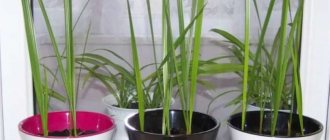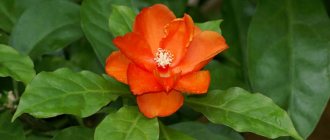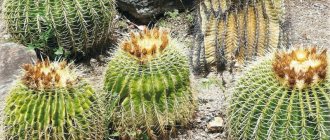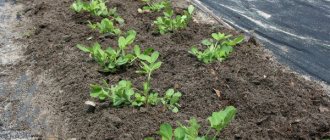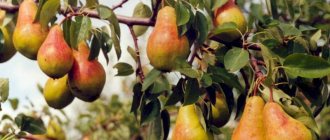Container gardening
Have you dreamed of growing citrus plants at home? Surely, many of you wanted to get tasty and healthy fruits on the windowsill, without going to the store or the East for this. Thanks to the right approach to this process, you will be able to enjoy juicy citrus fruits without leaving your home. In this article we will look at the very popular citrus calamondin, which has incredible taste. With a little effort, you can enjoy such fruits right in your apartment. Our article is dedicated to this particular plant, the secrets of its cultivation.
- 1 General description of the calamondin plant
- 2 Citrus calamondin: care at home after purchase 2.1 Rules for further care
- 2.2 Trimming calamondin
General description of the calamondin plant
Citrofortunella microcarpa or citrus calamondin micro is the name of a self-pollinating crop that is a hybrid of a kumquat and a tangerine tree. This compact tree is distinguished by leaves of a rich green hue, they exude a pleasant aroma. It blooms with white buds that have a good smell. This plant is also called indoor tangerine.
The bush is distinguished by small fruits that visually resemble small tangerines.
The berries have an orange peel and are very aromatic.
In its natural environment, this tree can reach up to 7 meters in height, but at home this figure does not exceed 150 centimeters. The root system of the bush is very well developed, the roots tightly entwine an earthen lump formed in a container. The stems and roots have pale brown bark.
Indoor mandarin calamondin bears fruit well in indoor conditions, since the flowers are self-pollinating. To increase the likelihood of fruit formation, you can additionally pollinate the bush using a brush. After 1-1.5 months, orange fruits are formed on the bush, visually reminiscent of tangerines. Calamondin can be eaten; the berries of the tree are eaten together with the peel. The fruits have specific taste qualities - the sour pulp goes well with the sweet skin.
Due to the fact that calamondin is a standard plant, it is actively used to decorate rooms.
You can learn more about growing plants in pots in our article “Container Gardening”
Content Rules
Lighting
To place calamondin, as a sun-loving plant, you should choose windows facing southeast or southwest. However, it should still be protected from the scorching summer midday rays.
Calamondin requires special care, starting on the eve of winter. Even in the fall, when the amount of lighting gradually decreases and the temperature remains the same, the plant at home begins to suffer. In the winter months, the ideal conditions for citrofortunella are low temperatures and additional lighting. Even the sunniest window will not be enough. Daylight hours for this plant should last 12 hours.
Air temperature
It is advisable to keep it in summer at a temperature of 18–26 degrees. Winter temperatures should be maintained within 15 degrees Celsius. Citrofortunella will not tolerate sub-zero temperatures. If the calamondin does not receive appropriate care in the winter, then, unfortunately, it will not be destined to please its owner for a long time. In just three years he could die.
There is also a specificity in maintaining the same temperature at different altitudes. That is, the air in the crown area should be the same temperature as in the rhizome area. For us, perhaps, the difference is not even perceptible, but the plant will not feel good from the changes.
It is advisable to place the pot with citrufortunella on a slight elevation, since the temperature of a regular floor is often slightly lower than that of the ceiling.
Under such conditions, the plant will not be able to absorb enough moisture from the soil. You should not place the pot on the very bottom, even if the “warm floor” system is turned on. In this case, calamondin, on the contrary, runs the risk of becoming oversaturated with excess moisture. Such incorrect care can lead to dropsy.
Soil requirements
For citrus plants, soil with weak or neutral acidity is suitable. A good option for calamondin is the purchased ready-made “Lemon” substrate.
Watering mode
The process, both in summer and winter, should be focused on the condition of the soil. It should always be kept moist, but the top layer should have time to dry between waterings.
For irrigation, soft, non-chlorinated water should be used.
The citrus plant needs fairly high air humidity. The room where it lives needs to maintain humidity at about 70 percent.
Fertilizing
Fertilizing should only occur during the growing season. In the autumn, and especially in the winter months, fertilizers should not be applied. Before applying fertilizer, the soil must first be moistened.
It is better to choose fertilizers special for citrus fruits. It is important not to overdo the dosage so as not to burn the root system. The manufacturer's dosage recommendations should be strictly followed, and before entering the rest period, first reduce the concentration by half.
Transfer
For calamondin, transplantation is a very dangerous procedure. During this process, there is a risk of damage to the very sensitive symbiotic fungus, which performs the function of nutrient absorption for the roots of the citrus fruit.
If necessary, the transplantation procedure can be carried out using the transshipment method and very carefully so as not to interfere with the earthen lump.
Diseases and pests
Citrus fruits can suffer at home primarily due to a lack or excess of lighting. In the first case, the sign will be large leaves of a rich green color, or yellow, falling leaves; in the second, the leaves will be light, discolored.
Citrus calamondin: care at home after purchase
Citrus calamondin indoors is usually sold with copious amounts of fruit. When fruiting ends, the trees stop developing and gradually die. To prevent this phenomenon, it is recommended to properly adapt the bush to new development conditions.
The first thing to do after purchasing a tree is to transplant it into a larger pot.
For this purpose, nutritious soil is used. The optimal composition is considered to be soil based on turf soil with rotted manure, and sand is also added. The ratio is 2 to 1 to 1. A prerequisite is the presence of a drainage layer. For this purpose, large expanded clay is used, and it is also replaced with walnut shells.
It is optimal to use the transshipment method. Carry out the process as quickly as possible to prevent the root system from drying out.
Quarantine is of great importance. The plant must be isolated from other crops for about 10 days. Get reliable protection from ultraviolet rays. Watering is carried out moderately; it is better to do without fertilizing. Check the bushes every day for harmful insects. Once you find them, treat them with insecticides.
Note! It is not allowed to rearrange the blooming calamondin or turn it over during flowering. This will cause the buds to fall off. If such a procedure is very necessary, then move the flowerpot daily, but no more than 1 mm.
Rules for further care
Homemade citrus calamondinas prefer good lighting, as well as a sufficient amount of heat . But direct exposure to the sun has a detrimental effect on the bush. Temperature readings should be +18…20°C. For abundant fruiting, you will need to provide the bush with a cold winter. The maximum permissible value is up to +12°C.
The bush is provided with abundant watering, especially during the hot season. In winter, it is recommended to reduce moisture; you can only spray the crown a little. In winter, the tree needs to be watered 2 times a week.
To get abundant calamondin fruits, you will need to regularly fertilize the bush using complex substances. In summer, citrus calamondin is fertilized once every 10 days, in winter – once every 30 days. Mineral compositions are optimal for this; you can also use ammonium nitrate, potassium chloride (5 and 2 grams per 1 liter of liquid).
You can learn more about caring for calamandin from this video
Root fertilizers are applied only to moist soil, the substance is poured in until the solution begins to flow out through the holes in the container. It is also recommended to add foliar fertilizers, since certain nutrients are better absorbed through the leaves.
Pruning calamondin
Citrofortunella calamondin requires mandatory pruning. The plant easily tolerates this procedure and is characterized by the rapid production of side shoots. Regular implementation of this process guarantees the production of a spherical dense crown, stimulates flowering and fruit formation. Pruning is done in the summer. Be sure to remove all damaged, dry branches. The cuts are made above the internode. Remember that on shoots that have been pruned, buds will form only after 1 year.
Replanting and pruning
Proper cultivation of a citrus tree involves replanting and pruning. If this is not done, the bush will stop growing and the crown will not form correctly.
Transfer
The first transplant of calamondin is carried out 1-2 weeks after purchase, so that the bush adapts and does not shed its leaves. If the tree is grown from a seed or cutting, it is recommended to transfer it to a new pot when its growth is about 20-25 cm. The procedure is carried out in early spring or at the end of February.
Transplanting a tree has its own rules:
- Take a pot with a larger diameter of 5-10 cm.
- Pay attention to the position of the root collar in the old tub, sprinkle the trunk with soil in the new place to the same level.
- The earthen ball around the roots is not touched. Saprophytic fungi live on the roots of citrus fruits, which help absorb nutrients from the soil. If the soil is removed, they will die, and with them the entire tree.
- After replanting, fertilizer is not applied for a month, because there is still a lot of nutrients in the soil.
It is better to prepare the soil for the plant yourself
The soil for replanting a tree can be bought in a store or made with your own hands. The following soil composition is suitable for citrus fruits:
- turf soil - 2 parts;
- sand - 1 part;
- humus - 1 part.
The soil should not be acidic, so it is not advisable to add peat to it. Land on which streptocarpus or limonella grows well is suitable. A drainage made of expanded clay or a mixture of sand and fine crushed stone is placed at the bottom of the pot. Calamondin transplantation is carried out annually in the first 3-4 years, then the procedure is repeated every 2-3 years.
Trimming
Standard pruning of calamondin is carried out in February. In summer, only long branches are shortened and the tops are pinched. It is recommended to prune the bush when its height is more than 25 cm. First, remove the upper skeletal branches, then move on to branches of 2-4 levels, leaving the trunk intact. The crown is cut in different ways. The most beautiful shapes are a ball, a pyramid, a cone. It is recommended to trim Citrofortunella like a bush or like a tree.
Methods for propagating calamondin
There are three methods to propagate the plant. Let's look at them in more detail:
- Cuttings .
Calamondin cuttings are taken from the top of the tree. It is important that there are many internodes. The formed cutting must be stimulated to develop. Zircon is used for this. Then prepare the soil composition and place the seedling there. The container with the cutting is placed in a room where there is an optimal level of humidity. Don't forget to cover the bush with cling film or a jar. If all these conditions are met, the plant will take root fairly quickly, on average it will take 1 month. The rooted seedling is placed in the same conditions as an adult bush. Learn more about calamandin cuttings in this video - Using the bone . Calamondin seeds are its seeds. They are collected from the fruits, dried, and then planted in a container with prepared soil. A miniature greenhouse is formed over the container; glass or cling film is suitable for this. The temperature should be up to +28°C. To grow calamondin from seed, the soil composition is regularly fertilized. When the first shoots form, the pot is placed in a warm and well-lit place. The grown seedlings are transplanted into separate containers.
- Vaccination method . To carry out the grafting, orange seedlings are prepared. They act as a rootstock. The scion will be a strong crop from which a small cutting is cut. The rootstock is cut at a height of 10 cm, and the bark is carefully removed from the branch with a knife. The cutting is formed obliquely, then it is tucked inside the orange seedling. Adhesive tape is used for fixation. The culture is covered with a bag and placed in a warm room. After 30 days, you can remove the coating, and after 6 weeks, the fixing tape is removed.
Reproduction
As with any other citrus plant, calamondins are propagated in two ways - cuttings and grafting .
In the first case, a cutting is cut , which is soaked in a heteroauxin solution for 10 hours. After this procedure, the cuttings are planted in the ground and covered with a glass jar to maintain a sufficiently high temperature in the region of 23°-26°C.
When young leaves appear, the jar is removed, and care becomes exactly the same as in the case of an adult plant. Propagation by cuttings is a fairly lengthy process and not all cuttings take root.
Many gardeners prefer to propagate calamondin by grafting. To do this, the cutting is grafted onto any seedling of a citrus plant, and it very quickly begins to grow and develop. Already in the second year, the young calamondin begins to bear fruit.
Common diseases and pests
Without following the growing rules, citrus calamondin falls off. This occurs due to an attack by parasites - scale insects, mites or thrips. Pests can destroy a bush even in adulthood. To fight parasites, acaricides are used. As a preventive measure, once every 30 days, the leaves of the crop are treated with a solution based on laundry soap.
Leaves may also fall off due to an attack by viruses or fungi. The most common are anthractosis or gommosis. To combat these problems, it is recommended to use Fitosporin. Also, if calamondin leaves turn yellow, a potassium permanganate solution is used to treat the bush.
Caring for Calamontodin after purchase
Most often, citrofortunella is purchased in a store, into which it ends up as a result of import from foreign countries. Therefore, a period of adaptation of calamondin to room conditions is required.
Often, after a purchase and a change in conditions, a flower becomes sick and its foliage actively falls off.
. A similar phenomenon is caused by stress suffered by calamondin. After all, his living conditions have repeatedly changed: the air temperature, its humidity, the degree of illumination of the room. The tree will need time and help from the owner to bounce back and adapt to the new apartment.
Advice!
If several leaves fall off the branches of a citrus hybrid within a day, you should put a plastic bag attached to the tree trunk on it as quickly as possible. Such actions will help to sharply increase the humidity level to 100%. At the same time, it is important not to forget to carry out the procedure of airing calamondin daily, for a short time, opening the package.
It is extremely important to provide the citrus plant with good lighting. If it is not enough, supplementary lighting with a special lamp is suitable.
Drafts in the room can negatively affect the development of citrofortunella.
What to do with a citrus plant after purchase - video
A plant grown abroad may contain special capsules with hormones in its root system. When leaves fly off a tree, it is necessary to extremely carefully and carefully check its root system and carefully transplant the citrofortunella into new soil and a new pot.
If roots are found that have succumbed to the process of decay, they must be cleaned immediately.
Even calamondin, which has lost absolutely all its foliage, has a chance of salvation. To resuscitate such a tree, you need to remove all existing fruits from it, which take all the strength from the plant, and cut off some branches. The cut areas must be processed using charcoal.
Photo of plant spraying
After these procedures, citrofortunella is sprayed with a special solution designed for the treatment of house plants and the prevention of diseases.
Spraying must be done once a day.
If the outcome is favorable, after half a month new young shoots will form on the trunk of the citrus hybrid.
Citrus calamondin: varietal diversity
There are not many varieties of this plant. The most popular are:
- Calamondin variegata or calamondin variagated. The main difference is the presence of an uneven white border on the leaves.
Photo of Calamondin variagated
The fruits are spherical in shape. - "Tiger" . The leaves of this bush have a thin golden stripe.
In addition to decorative purposes, citrus calamondin is actively used in the manufacture of cosmetics.

